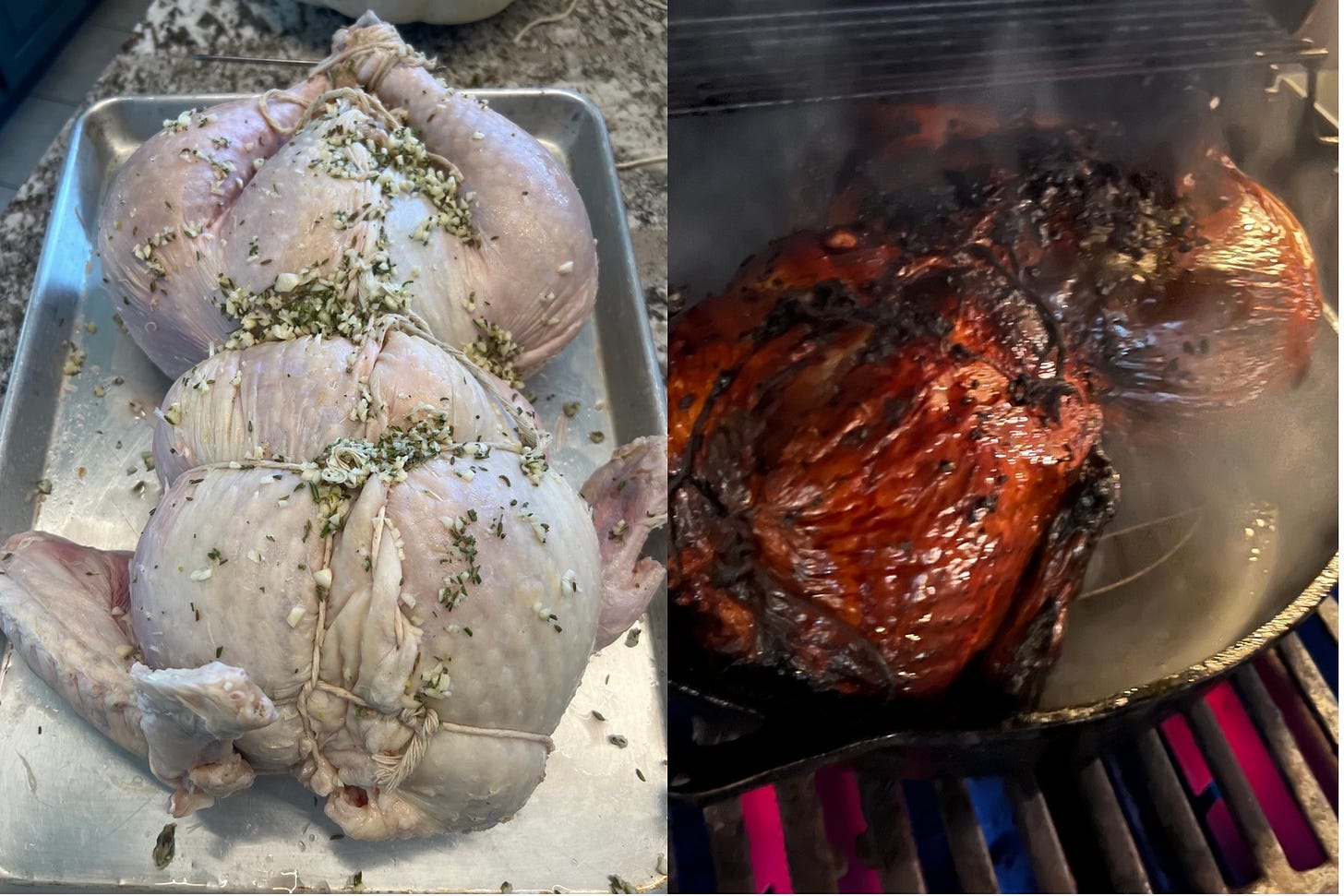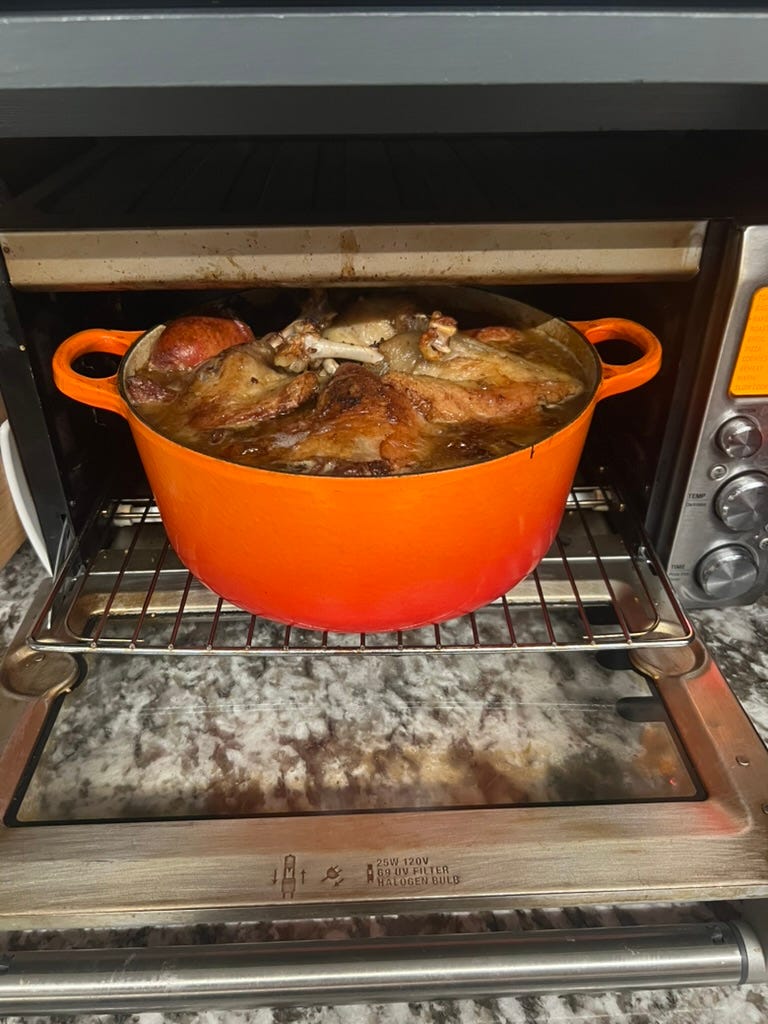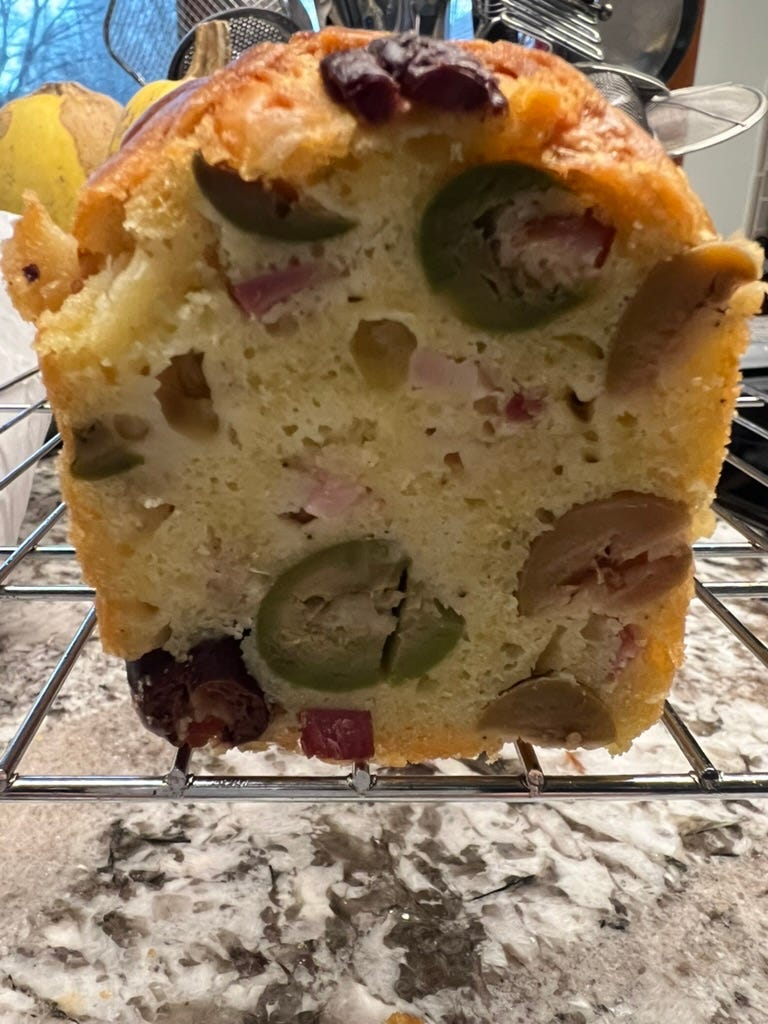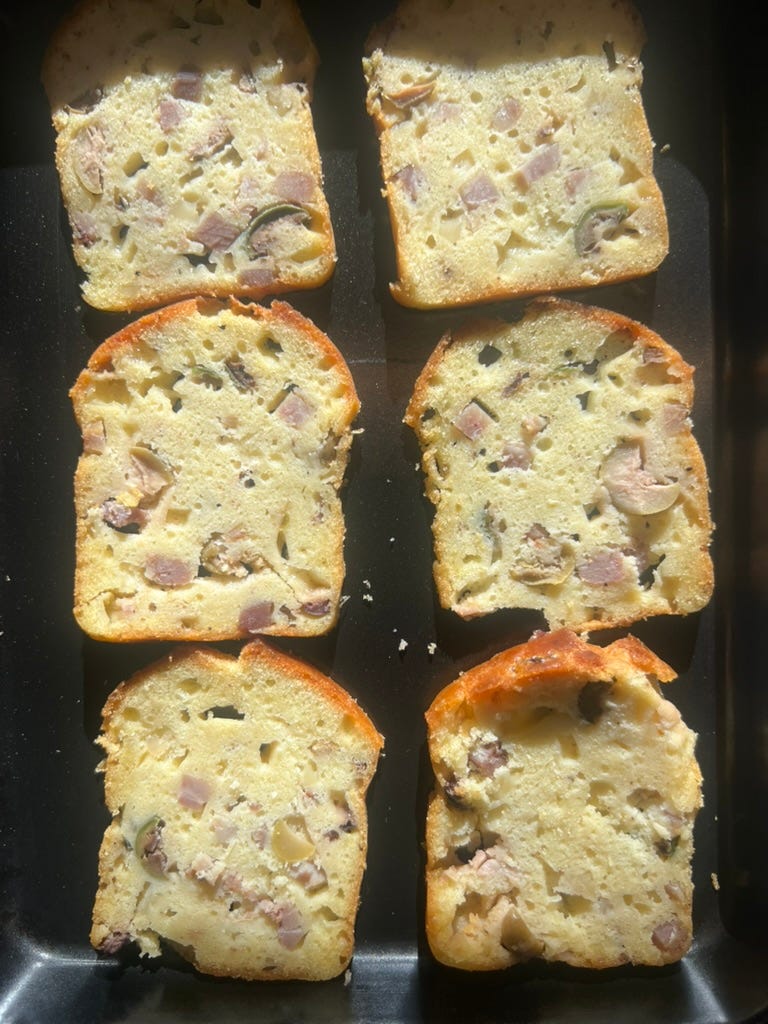Issue #184: Gâteau aux olives (sans four)
Thanksgiving in NH, Cooking for a Crowd without an Oven, A Savory Cake Perfect for Apéritifs
Well, that was quite a weekend. Nate and I hosted our first Thanksgiving in New Hampshire with the crew that usually gathers in Maine. There were 13 people staying with us. The kids, all six of them—who I remember as infants—are now in college or about to be. We gave them the guest house. I didn’t venture over there assuming it was best not to know. At any time there were two or three dogs running around. On Thanksgiving Day, we got seven inches of snow.
Did I mention my oven hasn’t worked for months? A pot of pasta water that boiled over shorted the electronics, causing the control panel to beep and blip its way through an endless and seemingly random selection of functions, error messages, and other warnings. It talks to us around the clock. There are moments when it is chattier than others. It greets us in the morning, seems excited to see us when we’ve been away. Three or four times it’s had what sounded like a nervous breakdown. We unplugged it to quiet the noise, hoping to reset the system. It continued to converse. But it won’t turn on.
Thanksgiving 2024 by the Numbers
13 house guests for 4 days
17 people for dinner 3 nights in a row
6 kids installed in the guest barn
5 cars
2 turkeys: 1 spatchcocked, 1 boned and stuffed
10 pounds of potatoes
7 inches of snow
0 ovens
Luckily, the stovetop works fine. But the oven can’t pull itself together.
I managed to get one of the two appliance repair people in the Upper Valley here quickly to diagnose the situation. I learned it is actually the starch, not the water, that is causing the problem, conducting electricity through the circuitry as though someone is pushing buttons. Don’t get me started on how a stove can be so fragile that a pot of pasta water boiling over can wipe out its central nervous system. Pasta water overflow is not a rare occurrence. I can only imagine that this is some sort of cultural commentary, the stove being German made, the pasta, of course, Italian.
Regardless, one of the two parts we need to fix the touch pad is back ordered. It was supposed to come in the 21st of November. I made the appliance folks promise to install it before our guests arrived for the holiday, 5 pm on the Tuesday before. Alas, the part didn’t come. I was rescheduled for December 10, after not only Thanksgiving had come and gone and but also a dinner for colleagues and a departmental holiday part for 50 that I agreed to host with Nate. Not having received the second part yet, I called this Monday to learn it was still back ordered. The technician would have to reschedule again. I’m hoping to have this oven working before the end of the year. But like our democracy, my hope is waning.
In the meantime, I’ve made anything and everything that needs to roast or bake or broil in our little Breville Smart Oven, which we usually just use for toast. I’m ready to do a commercial for this appliance. It has been a lifesaver and a workhorse. In addition to my weekly sourdough breads—baked in pans to fit the oven—I’ve roasted vegetables and meats, baked pies, cakes, cookies, and crackers, dried grapes to make raisins, and more. That Tuesday before Thanksgiving, when the repair guy was supposed to come, I even made an exceptionally yummy cassoulet.

For Thanksgiving weekend, one of our generous and helpful guests brought their own Breville Smart Oven, a larger version, in which we baked several pies and sides. Neither was larger enough for the turkeys, so I cooked the boned and stuffed one in a giant cast iron pan on the barbecue. The other was dispatched to the guest-barn oven and carted back in the snow once browned and roasted through. In situations like these, it’s good to have a lot of helpers around.
A Pan, A Cake, and Olives
One of the pans I have that fits in my small Breville oven is a cocktail loaf pan. Made by USA Pans, it’s a long, thin mold I have a certain nostalgia for (though mine is new) because it reminds me of the cocktail rye breads my mother used to buy for parties. Now I make my own cocktail ryes for parties, also sourdoughs and cornbreads. And for the holiday weekend, a savory French Gâteau aux olives as an hors d’oeuvres.
The first and best Gâteau aux olives I ever tasted was made by the late, great Francophile chef Robert Reynolds at a Provençal dinner he cooked at the James Beard House probably 20 years ago or more. Robert was a dear friend to me and a culinary inspiration to many, who stayed in my apartment whenever he came to the Big Pomme, which wasn’t often. When not in France, he was a West Coaster at heart, having made his home and his mark on the gastronomic landscapes consecutively in San Francisco, in Boulder, Colorado, and finally in Portland, Oregon, where the climate and ingredients reminded him of his beloved Brittany. He died in 2012 of a fast-moving cancer.
I remember stopping by to help Robert in the Beard House kitchen when he was prepping for that dinner. He had cracked and pitted what looked like gallons of Provençal olives by hand to bake into beautiful, fragrant, savory, olive oil-rich cakes. Perfect for an apéritif. That cake and the rest of the simple, elegant, precise, and perfectly artless French meal were a revelation I never forgot. And they solidified my admiration for Robert and his approach to food. Like many, I miss him.
Fast forward to the arrival in New Hampshire of a hungry crowd lounging around the fire, drinking cocktails and nibbling on things—everything!—over the holiday weekend. I decided to recreate Robert’s cake, a combination of memory and searching recettes on google.fr. I hope you enjoy it as much as I do. I’ll be making three more in my tiny oven this Sunday for that holiday party.
RECIPE: Gâteau aux Olives
Makes 1 loaf, regular or cocktail size, more than a dozen servings
2 scant cups unbleached all-purpose flour
2 1/2 teaspoons baking powder
1/2 teaspoon fine sea salt
A generous amount of freshly ground black pepper
1/2 cup dry white wine
1/2 cup dry white Vermouth
4 large eggs
1 scant cup (about 7 ounces) extra-virgin olive oil
1 1/2 cups (about 7 ounces) finely cubed cooked ham
1 cup (about 6 ounces) finely cubed Gruyère or goat cheese
1 1/4 cups green or assorted olives, pitted and coarsely chopped
1 tablespoon fresh or 1 1/2 teaspoons dried thyme
Preheat the oven to 350°F. Grease a 2”x13” cocktail loaf pan or standard 8”x4” loaf pan.
In a large mixing bowl, combine the flour, baking powder, sea salt, and black pepper, and whisk to blend. In a smaller bowl, beat the eggs with the white wine and vermouth until blended and pour them into the flour mixture, stirring just to combine. It’s okay if one or two streaks of flour remain. Pour in the olive oil about a quarter cup at a time and continue mixing until fully incorporated. Fold in the ham, Gruyère, olives, and thyme just until mixed through. Pour the batter into the prepared pan.
Bake the cocktail loaf for 45 to 50 minutes, the regular loaf for 55 to 60 minutes, until the top of the loaf is golden brown and crisp. An instant-read thermometer should read at least 200°F. in the center of the cake and come out clean. Remove from the oven and let cool on a rack for 15 minutes. Turn out of the pan, invert so it is right side up, and let cool completely. Slice the bread with a sharp serrated knife to serve. Wrapped, the cake will stay fresh for several days at room temperature.








What a glorious few days your guests had. Breville needs to spend a day with you on Beauty Hill.
Only you could pull that off! Sounds wonderful.